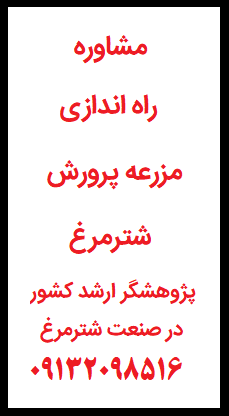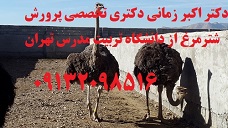مشاوره پرورش شترمرغ
شترمرغ در اوایل دهه 1990 با ژنتیک بسیار مختلط و بدون سابقه تولید معرفی شد. امروزه تولید محدود به تعداد معدود تولید کنندگان کوچک است که بطور جداگانه بیشتر محصولات گوشت را از طریق بازارهای محلی کشاورزان بفروش می رسانند. این دامداران ان حاصل پرورش خود را دارند ، جوجه های خود را جوجه ریزی و پرورش می دهند. کشتاربا پروانه مجاز انجام می شود. در حال حاضر کشاورزان مسئول تمام بازاریابی خود هستند. هیچ تولیدی تحت تأمین قرارداد برای تهیه عمده فروشان یا خرده فروشان انجام نشده است.
آموزش پرورش شترمرغ
کار در حجم کم چالش های مهمی را هم در به حداکثر رساندن درآمد و هم برای کنترل هزینه های تولید نشان می دهد ، زیرا دستیابی به اقتصاد سود زا امکان پذیر نیست. شترمرغ ها در درجه اول برای گوشت خود تولید می شوند ، با پوست ، چربی و پرهای آنها درآمد اضافی در اختیار شما قرار می دهد. پوست ها به طور کلی به نمایندگی ها فروخته می شوند ، اما برای فروش حداقل تعداد 200 پوست مورد نیاز است ، بنابراین به مزرعه بزرگ برای تهیه حجم کافی از پوست نیاز می باشد.
دکتر اکبر زمانی متخصص پرورش شترمرغ
پژوهشگر ارشد کشوری در صنعت شترمرغ
مدرس دانشگاه و عضو کمیته علمی دانشگاه
مشاور تلفنی پرورش شترمرغ ایران
Dr Zamani PHD TMU Iran
akbarzaman
09132098516
The ostrich is very adaptable and thrives under extreme conditions. Among the many ways of regulating its body temperature, it controls heat loss during cold weather by covering its thighs with its wings, and during hot weather, by lifting and moving its wings, it creates a gentle breeze. The feathers are excellent insulators, minimizing heat gain from direct solar radiation, as well as reducing heat loss during cold desert nights.
It has a remarkable tolerance to heat, withstanding air temperatures of 56°C without undue stress. Heat is lost by panting via the well-developed air sac system that avoids overventilation of the lungs and consequent dangerous water loss (Jones, 1982). Adaptations of the blood circulatory system permit its body to heat up to a greater ex
tent than those of other warm-blooded animals while still keeping the head at a safe temperature (Crawford and Schmidt-Nielsen, 1967). Ostriches rarely seek shade, as most desert animals regularly do. Furthermore, the ostrich's urine contains uric acid carried in a mucus-like substance that helps to minimize water loss (Levy et al., 1990; Yagil et al., 1990).
Ostriches may be found in a variety of open habitats. They normally avoid areas of thick bush or heavy tree cover, and inhabit wooded grasslands and other open country. Semi-arid, open and short-grass plains are usually associated with the highest ostrich densities. They are also able to thrive in very poorly vegetated areas.
Behaviour of the ostrich
Ostriches are completely diurnal. They are on their feet for most of the daylight hours, except when dust-bathing, resting or nesting. They invariably sit down at dusk and remain virtually inactive throughout the night unless disturbed (Degen, Kam and Rosenstrauch, 1989).
The chicks and juveniles are strictly gregarious and always remain in compact groups. Adults are semi gregarious and tend to be attracted to each other for short periods. Like camels, ostriches can travel for long distances in search of food and water.
In addition to temperature control, ostriches use their wings for a variety of display purposes, including courting, protecting eggs and young and submission (Sauer, 1966).
The ostrich's posture communicates information to other birds. A more confident and aggressive bird will hold its head and neck high, with the front of the body tilted upwards and the tail up, while a submissive bird will hold its head low and its tail down (Bertram, 1992).
Sexual characteristics
The wild ostrich is sexually mature at four to five years of age, while the domesticated ostrich is mature at two to three years; the female matures slightly earlier than the male. Male ostriches attain the black-and-white plumage when mature. Females and immature birds have a much duller colouring, with grayish-brown plumage. The young have spiky, black-tipped buff-coloured plumage until they are about four months of age. The plumage of the cock is brighter during the breeding/mating season, while the skin, usually light blue, becomes bright red (scarlet) over the beak, forehead and around the eyes, and the leg scales and toes become pink.
Male and female chicks are very similar in appearance and their sex can only be determined by examining their sexual organs. This is difficult as the penis of the male is still tiny and easily confused with the clitoris of the female (Gandini and Keffen, 1985; Samour, Markham end Nieva, 1984). From about seven to eight months of age, the sex can be determined when the bird urinates or defecates, as the penis emerges at these times. It is interesting to note that, unlike most birds, the male ostrich has a penis and that micturition and defecation are separate acts, although one normally follows the other almost immediately.
Full distinction between sexes is reached at about two years of age. The wing quills are pure white in the male, while they are ringed with grey or black in the female. The tail feathers of the male are white or yellowish brown and those of the female are mottled light and dark grey. The thighs of the adult ostrich are almost devoid of feathers.
It is important to note that the scarlet coloration of the male is dependent on the presence of mature testes, while its black plumage is dependent on the absence of ovaries. A castrated cock never acquires scarlet coloration, but its feathers are the normal black of the cock. Removal of the testes after sexual maturity has little effect on the bird's sexual instincts, and it continues the mating procedure (Osterhoff, 1979, 1984).
The breeding season
Ostriches are seasonal breeders, breeding only during particular seasons of the year. On average, the breeding/mating season lasts from six to eight months every year, although the timing and duration of breeding can vary with latitude and altitude (Shanawany, 1994a). In the northern hemisphere, breeding commences during March and ends around August/September (Leuthold, 1977), while in the southern hemisphere it begins around July/August and finishes by the end of March (Jarvis, Jarvis and Keffen, 1985)
Mating
Male ostriches are polygamous and can mate with more than one female. In the wild, the cock starts nesting with one or two or even more hens. Domesticated ostriches are kept in pairs (one male and one female) or in trios (one male and two females) for the breeding season (Shanawany, 1993).
Part of the courtship display in ostriches involves the "rolling" of the male. He squats (goes down on his haunches) and flaps his wings backwards and forwards while hitting his head on alternate sides of his back, making a thudding sound. Usually silent, the male has a hollow booming call in the breeding season. The female holds her wings horizontally and flutters the tips. Her head is held low, and she opens and shuts her beak. When she is crouching, the male places his left foot next to hers and mounts with his right foot on her back. His penis passes into the cloaca of the female. Consummation is usually accompanied by his groaning, while the female snaps her beak and shakes her head (Osterhoff, 1984).
The female starts to lay fertile eggs shortly after mating. Eggs are laid every other day in clutches (sequences) of 20 to 24 eggs. The hen stops laying for a period of seven to ten days, after which she starts a new clutch. High-producing females lay between 80 to 100 eggs during the breeding season.
The eggs are laid in a communal nest on the ground, with other females laying their eggs in the same nest (Bertram, 1992). If the eggs are not removed, the female will start incubating them during the day, leaving the male to incubate from dusk to dawn. The male's jet-black feathers assist in hiding the eggs during the night. For commercial ostrich farming, it is important that all eggs are removed from the nest at least twice daily (Shanawany, 1994b), since, if allowed to incubate, the female will stop laying until the chicks have reached four to five weeks of age, resulting in financial loss.
دکتر اکبر زمانی متخصص پرورش شترمرغ
پژوهشگر ارشد کشوری در صنعت شترمرغ
مدرس دانشگاه و عضو کمیته علمی دانشگاه
مشاور تلفنی پرورش شترمرغ ایران
Dr Zamani PHD TMU Iran
akbarzamani.ir
09132098516



